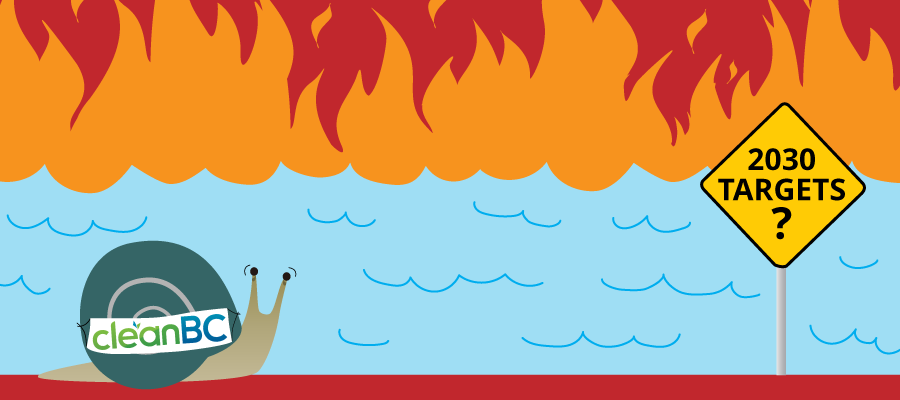Can CleanBC reach its 2030 GHG target? A closer look at industrial emissions

In the wake of negotiations in Glasgow to push forward global climate action, it is clear that rich countries and jurisdictions like BC are not doing enough to cut greenhouse gas (GHG) emissions. On the heels of Glasgow, the massive flooding in southern BC should be another wake-up call on top of a year of extreme weather events in the province.
The province’s updated climate plan, CleanBC, does not align with the urgency demanded by climate scientists. The BC Climate Emergency Campaign is calling for a 60% reduction in GHG emissions by 2030–compared to the province’s current target of 40%–and 100% by 2040 (all below 2007 levels).
But even on its own limited terms, there’s good reason to be skeptical of the BC government’s claim that the province will now exceed its 2030 GHG target. See the addendum at the end of this piece for a brief history of past claims.
There are indeed some positive steps forward in the October 2021 CleanBC update:
- The timeline for zero-emission new buildings has been advanced from 2032 to 2030.
- In transportation there are accelerated requirements for zero-emission vehicles (90% zero emission cars by 2030, 100% by 2035) and improvements in the low-carbon fuel standard.
- The province will cap emissions for natural gas utilities.
- It will match the federal minimum carbon price of $170 per tonne by 2030.
In the crucial area of industrial emissions, which constitute a third of the provincial total, commitments are more vague. BC has taken a light hand to date out of concerns that climate policy will affect “competitiveness” and thus lead to the loss of economic activity and jobs. Similarly, there is little in CleanBC to reduce emissions from freight transportation. The province’s updated climate plan does not align with the urgency demanded by climate scientists.
From the CleanBC update, the province will require new industrial facilities to align with the province’s 2030 and 2040 targets and to have plans to be net zero by 2050. Reductions in industrial emissions are also being targeted by a new BC Hydro electrification program ($105 million in incentives).
The BC government is now seeking to align its industrial emissions policies with the federal government by 2023. The federal large emitters carbon pricing regime is different than BC’s, with large emitters exempted for the bulk of their emissions, so they may only pay pennies on the dollar when compared to households. The federal system could provide another loophole for industry through the proposed federal GHG offset system, which would allow those large emitters to buy offsets in lieu of paying carbon taxes.
It’s hard to know whether these moves will shift the needle on industrial emissions. Civil society won a small victory in pressing the government for sectoral targets: a 33-38% reduction by 2030 target for the oil and gas sector, and 38-43% reduction for other industries. Those targets are significant but they also feel like the same old policy in BC of setting a target and not having a plan to meet it. Maybe by 2023 such a plan will be in place, or not. The federal system could provide another loophole for industry through the proposed federal GHG offset system.
Nor has the BC government said a clear no to more LNG plants. The province continues to subsidize fracking operations in the northeast. While a royalty review is welcome and may lead to some changes, subsidies for future production have already been issued in the form of credits against future royalties.
An area to watch closely is a precise-sounding commitment to reduce methane emissions by 75% by 2030. However, there’s a vast discrepancy between reported emissions (based on data from the industry) and larger emissions when actual field measurements have been done. Much of the leakage of methane at fracking sites and from old leaky wells is ignored. BC just gave another gift to fracking companies by allowing them to delay clean up of old wells.
With the CleanBC update, the BC government moves the yardsticks, though as Seth Klein points out, these actions strongly suggest that the government does not believe we are in a climate emergency. An emergency mindset would mean taking meaningful action to challenge the oil and gas industry in BC, and the failure to do so is perhaps the biggest hole in BC’s climate plan.
Addendum: BC’s climate track record
Climate policy in BC is full of big claims of action, along with precious little in terms of results.
Let’s roll back the clock. Back in 2008, BC tabled its first Climate Action Plan to reach a then-target of a 33% reduction in emissions by 2020 (relative to 2007). At the time, we were told that the plan took us 73% of the way to the target, based on modeling done in support of the plan by Mark Jaccard and Associates.
Additional measures to close the gap were promised but never implemented. In spite of winning kudos for its plan, the BC government lost interest in climate action and instead doubled down on fossil fuel production through liquefied natural gas (LNG) exports.
Nor did the climate policies implemented achieve the results originally promised. That “73% of the way to the target” should have translated into a 24% reduction by 2020, but as of 2019 BC’s emissions were actually 5% higher.
Having missed the window for 2020, a change of government saw BC table a new target of a 40% reduction in emissions by 2030 (still relative to 2007). The 2018 CleanBC plan came with some new measures along with a deja vu claim (via modelling done by Navius) that its measures would get us 75% of the way to the target.
Yet, by the time of the October 2021 CleanBC update those previous measures have been restated to only contribute 32 to 48% of the 2030 target.
Almost three years later, the CleanBC update now promises its actions put the province on a pathway to its 2030 target. Until more concrete plans are in place for industrial emissions, oil and gas in particular, we shouldn’t be fooled by targets.
Topics: Climate change & energy policy, Economy, Environment, resources & sustainability, Fracking & LNG


